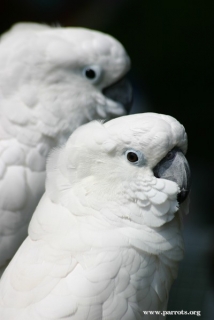White-crested Cockatoo |
|
|
Also known as: Great White Cockatoo, White Cockatoo, Umbrella Cockatoo
Photos
View in GalleryDid You Know?
Is more tolerant to habitat disturbance than the Moluccan Cockatoo and is found in selectively logged areas, plantations, and degraded woodlands.Academic Research
Related publications: Cacatua albaSpecies Profile
Genus: Cacatua | Species: alba
Size:
46cm (18 in)
Weight:
550g (19.25 oz)
Subspecies including nominate:
one
Colour Adult:
Both adults completely white; have backward curving crest; yellow suffusion under wings. Eye ring off white. Eye dark brown in male, red/brown in female.
Colour Juvenile:
As adult but with dark grey eye.
Call:
Loud, grating screech; alarm is hissing voice.
Listen NowVideo Links:
Video 1 | Video 2More Information:
Content Sources:
CITES
BirdLife International
Cornell Lab of Ornithology/Birds of the World
A Guide to Parrots of the World, Juniper and Parr, 1998
Parrots of the World, Forshaw and Cooper, 1989.
Vanished and Vanishing Parrots, Forshaw, 2017.
Parrots of the World, Forshaw, 2006.
Parrots in Aviculture, Low, 1992.
Avian Pediatric Seminar Proceedings, 1988.
Psittacine Aviculture, Schubot, Clubb and Clubb, 1992.
Parrots: Status Survey and Conservation Plan 2000-2004, Snyder, McGowan, Gilardi and Grajal, 2000.
Photos
View in GalleryDid You Know?
Is more tolerant to habitat disturbance than the Moluccan Cockatoo and is found in selectively logged areas, plantations, and degraded woodlands.Academic Research
Related publications: Cacatua albaSpecies Care
Captive Status:
Common
Longevity:
40-60 yrs
Housing:
Walk-in aviary, minimum length 3m (9.8 ft).
Diet:
Mixture of small seeds: canary, oats, safflower; spray millet, limited sunflower seed, dry, soaked or sprouted; sprouted beans such as mung, peas; corn on the cob, green leaves such as: Swiss chard, lettuce, dandelion, chickweed; fresh vegetables such as: carrot, celery, zucchini, green beans, peas in the pod; fresh fruit such as: apple, banana, orange, cactus fruits and others; complete kibble, walnuts, hazelnuts, pecans, roasted peanuts.
Enrichment:
Bird-safe chewables (fir, pine, elder, willow or sterilized pine cones), different sized perches, ladders, large link chains (durable plastic) swings, bathing using overhead misters or spray bottles, socialization.
Nest Box Size:
Vertical box 12" x 12" x 36" (30.5cm x 30.5cm x 91.5cm).
Clutch Size:
2
Incubation Time:
28 days
Fledging Age:
13-15 weeks
Hatch Weight:
18g (0.6 oz)
Peak Weight:
470-764g (16.5-26.7 oz)
Weaning Weight:
481-548g (16.8-19.1 oz)
Photos
View in GalleryDid You Know?
Is more tolerant to habitat disturbance than the Moluccan Cockatoo and is found in selectively logged areas, plantations, and degraded woodlands.Academic Research
Related publications: Cacatua albaSpecies Wild Status
World Population:
Unknown, decreasing.
IUCN Red List Status:
Endangered
CITES Listing:
Appendix II
Threat Summary:
Affected by trapping and rapid habitat loss. Currently, both adults and young are taken for trade. Recent research indicates that rapid declines are predicted to increase in the future (Vetter 2009).
Range:
Found on Halmahera, Bacan, Ternate, Tidore, Kasiruta and Mandiole Islands in N Moluccas, Indonesia.
Habitat:
Found in lowland and hill forest up to 600m (1968 ft). Are able to adjust to secondary growth.
Wild Diet:
Forages on arboreal seeds and fruits; birds observed bark-peeling and investigating epiphytes, suggesting that they may also eat insects.
Ecology and Behaviour:
Spends most of its time in the forest canopy, seen in pairs or small groups. Gathers in larger groups at dusk to roost.
Clutch and Egg Size:
2 elliptical eggs, 41.0 x 31.0mm (1.6 x 1.2 in).
Breeding Season:
April-August. Nest is in cavity in large forest tree.
Photos
View in GalleryDid You Know?
Is more tolerant to habitat disturbance than the Moluccan Cockatoo and is found in selectively logged areas, plantations, and degraded woodlands.Academic Research
Related publications: Cacatua albaMembers Only Resources
Please log-in now to find more research, resources and tools.
Not a Member?
Find more great information:
Gain exclusive access to 600+ pages of additional research, seminars and podcasts, specialists to ask your toughest questions, and dozens of other fun resources - when you become a WPT member.
Join Today >>

































